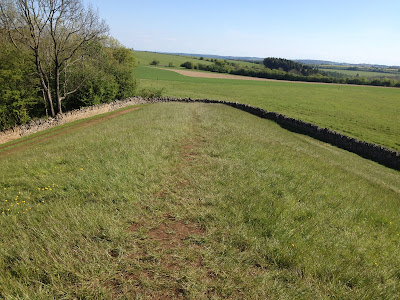This is a tomb
near Kirkwall on the north coast of Mainland Orkney, built by Neolithic farmers
around 3000BC.
Dozens of
tombs were built around Orkney and each was probably linked to a small
community who farmed the immediate area. There was a small Neolithic settlement
at the foot of Cuween Hill. Unlike the chambered tombs of southern Britain such
as Belas Knap and Wayland's Smithy, Orkney’s tombs were often in use for a
thousand or more years and may contain several hundred bodies.
Cuween
comprises five dark, damp chambers leading out from a central chamber. This is
reached by a long, low passage entered at a crawl. Some of the chambers are
level with the central chamber; others are raised; others have a flagstone
divider. The arrangement seems entirely organic with no overall grand design. This
is the case with many of the tombs, which each have a unique layout. Perhaps
the builders worked entirely through intuition or with the help of spirit guides
who, while in a trance state, ‘drew’ the tomb into this world.
Cuween was excavated
a century ago and was found to contain the bones of eight people and 24 dog
skulls. The small number of human bones suggests the tomb was periodically cleared
of bones, or perhaps emptied at the end of its use-life. The presence of dogs
is unique, although other tombs contained animal bones such as red deer, otters
or sea eagles, and may indicate a community totem or spirit guide. Dogs are commonly
seen as guardians of the underworld or as guides for the dead. The dogs were
collie-sized and resembled a grey wolf.
The view from
the cairn across the farmland and the sea
Cuween
probably derives from ‘kewing’, meaning cattle pasture. Due to the short
growing season at this northern latitude, cattle have always formed the basis of
Orkney’s agriculture. In more recent folklore it was known as the Fairy Knowe.
The tomb was
cut out of the bedrock and roofed with flagstones then covered with earth. From
a distance it blends into the hillside in this respect resembles the southern tombs. Its purpose was to form a bond with the land, and its influence spread
over the farmland below it.
Most of the
Orkney tombs face out to sea. The sea was a provider and nurturer as much as
the land, and it makes sense for the guardian influence of the ancestors to extend
across the water. It may also reflect the journey of the souls of the deceased.
Like many of
the tombs, Cuween had been carefully sealed up. This generally seems to have
happened around 2500BC, when Orkney’s Neolithic culture dramatically ended. The
tombs gradually became the haunt of fairies and ghosts, left undisturbed for
fear of violent repercussions from angry ghosts.












